Theodordou, A., et al. Oxytocin and Social Perception: Oxytocin Increases Perceived Facial Trustworthiness and Attractiveness. Hormones and Behavior, June 2009.
Tucker, W. Polygamy Chic. American Enterprise Online, March 21, 2006.
Unkel, C, et al. Oxytocin Selectively Facilitates Recognition of Positive Sex and Relationship Words. Psychological Science 19, no. 11 (2008).
Vadney, D. And the Two Shall Become One. Physicians for Life // http://www.physiciansforlife.org/content/view/1492/105/.
Waldheer, M., and I. Neumann. Centrally Release Oxytocin Mediates Mating-Induced Anxiolysis in Male Rats. Proceedings of the National Academy of Sciences, October 16, 2007.
Walum, PL, et al. Variation in the Oxytocin Receptor Gene (OXTR) Is Associated with Pair-Bonding and Social Behavior. Presented at 2011 Behavior Genetics Association 41st Annual Meeting, Newport, Rhode Island, June 8, 2011.
Young, L., and X. Wang. The Neurobiology of Pair Bonding. Nature Neuroscience, September 26, 2004.
Young, L., et al. Cellular Mechanisms of Social Attachment. Hormones and Behavior, September 2001.
Глава 6
Albers, H. The Regulation of Social Recognition, Social Communication and Aggression: Vasopressin in the Social Behavior Neural Network. Hormones and Behavior, November 2011.
Arch, S., and P. Narins. Sexual Hearing: The Influence of Sex Hormones on Acoustic Communication in Frogs. Hearing Research, June 2009.
Bos, P., et al. Acute Effects of Steroid Hormones and Neuropeptides on Human Social-Emotional Behavior: A Review of Single
Administration Studies. Frontiers in Neuroendocrinology, January 21,2011.
Bos, P., et al. Testosterone Decreases Trust in Socially Naive Humans. Proceedings of the National Academy of Sciences, May 24, 2010.
Burnham, T. High-Testosterone Men Reject Low Ultimatum Game Offers. Proceedings of the Royal Society B, July 5, 2007.
Carter, S., et al. Consequences of Early Experiences and Exposure to Oxytocin and Vasopressin Are Sexually Dimorphic. Developmental Neuroscience, June 17, 2009.
Dewan, A., et al. Arginine Vasotocin Neuronal Phenotypes Among Congeneric Territorial and Shoaling Reef Butterflyfishes: Species, Sex, and Reproductive Season Comparisons. Journal of Neuroendocrinology, December 2008.
Donaldson, Z. Interview with the authors, July 25, 2011.
Donaldson, Z., and L. Young. Oxytocin, Vasopressin, and the Neurogenetics of Sociality. Science, November 6, 2008.
Donaldson, Z., et al. Central Vasopressin V1a Receptor Activation Is Independently Necessary for Both Partner Preference Formation and Expression in Socially Monogamous Male Prairie Voles. Behavioral Neuroscience, February 2010.
Ebstein, R., et al. Genetics of Human Social Behavior. Neuron, March 25, 2010.
Etkin, A., et al. Emotional Processing in Anterior Cingulate and Medial Prefrontal Cortex. Trends in Cognitive Sciences, February 2011.
Ferguson, J., et al. The Neuroendocrine Basis of Social Recognition. Frontiers in Neuroendocrinology 23 (2002): 200–224.
Fitzgerald, F. The Great Gatsby. New York: Scribner's, 1953.
Francis, D., et al. Naturally Occurring Differences in Maternal Care Are Associated with the Expression of Oxytocin and Vasopressin (V1a) Receptors: Gender Differences. Journal of Neuroendocrinology, May 2002.
French, K. Interview with the authors, October 4, 2011.
Gobrogge, K., et al. Anterior Hypothalamic Vasopressin Regulates Pair-Bonding and Drug-Induced Aggression in a Monogamous Rodent. Proceedings of the National Academy of Sciences, November 10, 2009.
Gospic, K., et al. Limbic Justice-Amygdala Involvement in Immediate Rejection in the Ultimatum Game. PLoS Biology, May 3, 2011.
Griskevicius, V., et al. Blatant Benevolence and Conspicuous Consumption: When Romantic Motives Elicit Strategic Costly Signals. Journal of Personality and Social Psychology 93, no. 1 (2007).
Guastella, A., et al. Intranasal Arginine Vasopressin Enhances the Encoding of Happy and Angry Faces in Humans. Biological Psychiatry, June 15, 2010.
Hammock, E., and L. Young. Microsatellite Instability Generates Diversity in Brain and Sociobehavioral Traits. Science, June 10, 2005.
Hartmann, E. The Philosophy of the Unconscious: Speculative Results According to the Inductive Method of Physical Science. Edinburgh: Ballantyne, Hanson, and Company, 1884.
Heinrichs, M. Interview with the authors, March 30, 2011.
Holmes, C, et al. Science Review: Vasopressin and the Cardiovascular System Part 1-Receptor Physiology. Critical Care, June 26, 2003.
Homer. The Odyssey. New York: Penguin Classics, 1966.
Hopkins, W. Presentation, Workshop on the Biology of Prosocial Behavior, Emory University, October 23–24, 2011.
Hopkins, W., et al. Polymorphic Indel Containing the RS3 Microsatellite in the 51 Flanking Region of the Vasopressin Receptor Gene Is Associated with Chimpanzee (Pan troglodytes) Personality. Genes, Brains and Behaviour, April 20, 2012.
Ishunina, Т., and D. Swaab. Vasopressin and Oxytocin Neurons of the Human Supraoptic and Paraventricular Nucleus; Size Changes in Relation to Age and Sex. Journal of Clinical Endocrinology and Metabolism 84, no. 12 (1999).
Ishunina, Т., et al. Activity of Vasopressinergic Neurons of the Human Supraoptic Nucleus is Age– and Sex-Dependent. Journal of Neuroendocrinology, April 1999.
Israel, S., et al. Molecular Genetic Studies of the Arginine Vasopressin la Receptor (AVPR1 A) and the Oxytocin Receptor (OXTR) in Human Behaviour: From Autism to Altruism with Some Notes in Between. Progress in Brain Research, 2008.
Klieman, D., et al. Atypical Reflexive Gaze Patterns on Emotional Faces in Autism Spectrum Disorders. Journal of Neurosience, September 15,2010.
Knafo, A., et al. Individual Differences in Allocation of Funds in the Dictator Game Associated with Length of the Arginine Vasopressin la Receptor RS3 Promoter Region and Correlation Between RS3 Length and Hippocampal mRNA. Genes, Brain and Behavior, April 2008.
Levi, M., et al. Deal or No Deal: Hormones and the Mergers and Acquisitions Game. Management Science, September 2010.
Lim, M., et al. Enhanced Partner Preference in a Promiscuous Species by Manipulating the Expression of a Single Gene. Nature, June 17, 2004.
Lim, M., et al. The Role of Vasopressin in the Genetic and Neural Regulation of Monogamy. Journal of Neuroendocrinology, April 2004.
Lynn, M. Determinants and Consequences of Female Attractiveness and Sexiness: Realistic Tests with Restaurant Waitresses. Archives of Sexual Behavior, October 2009.
McGraw, L., and L. Young. The Prairie Vole: An Emerging Model Organism for Understanding the Social Brain. Trend in Neuroscience, February 2010.
Meyer-Lindenberg, A. Impact of Prosocial Neuropeptides on Human Brain Function. Progress in Brain Research, 2008.
Meyer-Lindenberg, A., et al. Oxytocin and Vasopressin in the Human Brain: Social Neuropeptides for Translational Medicine. Nature Reviews Neuroscience, September 2011.
Meyer-Lindenberg, A., et al. Genetic Variants in AVPR1A Linked to Autism Predict Amygdala Activation and Personality Traits in Healthy Humans. Molecular Psychiatry, October 2009.
Miczek, K., et al. Escalated or Suppressed Cocaine Reward, Tegmental BDNF, and Accumbal Dopamine Caused by Episodic versus Continuous Social Stress in Rats. Journal of Neuroscience, July 6, 2011.
Mulcahy, S. Interview with the authors, October 28, 2011.
Neumann, I., et al. Aggression and Anxiety: Social Context and Neurobiological Links. Frontiers in Behavioral Neuroscience, March 30, 2010.
Normandin, J., and A. Murphy. Somatic Genital Reflexes in Rats with a Nod to Humans: Anatomy, Physiology, and the Role of the Social Neuropeptides. Hormones and Behavior, February 19, 2011.
Ophir, A. Variation in Neural V1aR Predicts Sexual Fidelity and Space Use Among Male Prairie Voles in Semi-Natural Settings. Proceedings of the National Academy of Sciences, January 29, 2008.
Prenatal Shaping of Behavior. British Medical Journal, April 25, 1964.
Prichard, Z., et al. AVPR1A and OXTR Polymorphisms Are Associated with Sexual and Reproductive Behavioral Phenotypes in Humans. Human Mutation, November 2007.
Schmadeke, S. Homer Glen Man Pleads Guilty to Killing Cat in Jealous Rage. Chicago Tribune, March 23, 2011.
Shalev, L, et al. Vasopressin Needs an Audience: Neuropeptide Elicited Stress Responses Are Contingent Upon Perceived Social Evaluative Threats. Hormones and Behavior, April 30, 2011.
Shirtcliff, E., et al. Neurobiology of Empathy and Callousness: Implications for the Development of Antisocial Behavior. Behavioral Sciences and the Law, August 2009.
Stribley, J., and S. Carter. Developmental Exposure to Vasopressin Increases Aggression in Adult Prairie Voles. Proceedings of the National Academy of Sciences, October 26, 1999.
Takahashi, H., et al. Dopamine D1 Receptors and Nonlinear Probability Weighting in Risky Choice. Journal of Neuroscience, December 8, 2010.
Thompson, R., et al. The Effects of Vasopressin on Human Facial Responses Related to Social Communication. Psychoneuroendocrinology, January 2009.
Thompson, R., et al. Sex-Specific Influences of Vasopressin on Human Social Communication. Proceedings of the National Academy of Sciences, May 16, 2006.
Todd, K. Interview with the authors, October 4, 2011.
Uzefovsky, F, et al. Vasopressin Impairs Emotion Recognition in Men. Psychoneuroendocrinology, August 17, 2011.
Von Dawans, B. Interview with the authors, March 30, 2011.
Wagenaar, D., et al. A Hormone-Activated Central Pattern Generator for Courtship. Current Biology, March 23, 2010.
Waldherr, M., and I. Neumann. Centrally Released Oxytocin Mediates Mating-Induced Anxiolysis in Male Rats. Proceedings of the National Academy of Sciences, October 16, 2007.
Walum, H., et al. Genetic Variation in the Vasopressin Receptor la Gene (AVPR1 A) Associates with Pair-Bonding Behavior in Humans. Proceedings of the National Academy of Sciences, September 16, 2008.
Williamson, M., et al. The Medial Preoptic Nucleus Integrates the Central Influences of Testosterone on the Paraventicular Nucleus of the Hypothalamus and Its Extended Circuitries. Journal of Neuroscience, September 1, 2010.
Winslow, J., et al. A Role for Central Vasopressin in Pair Bonding in Monogamous Prairie Voles. Nature, October 7, 1993.
Young, L., and X. Wang. The Neurobiology of Pair Bonding. Nature Neuroscience, September 26, 2004.
Young, L., et al. Cellular Mechanisms of Social Attachment. Hormones and Behavior, September 2001.
Young, L., et al. Increased Affiliative Response to Vasopressin in Mice Expressing the V1a Receptor from a Monogamous Vole. Nature, August 19, 1999.
Zink, C, et al. Vasopressin Modulates Medial Prefrontal Cortex-Amygdala Circuitry During Emotion Processing in Humans. Journal of Neuroscience, May 19, 2010.
Глава 7
Aragona, В., et al. Nucleus Accumbens Dopamine Diff erentially Mediates the Formation and Maintenance of Monogamous Pair Bonds. Nature Neuroscience, January 2006.
Bosch, O. Interview with the authors, December 20, 2011.
Bosch, O., et al. The CRF System Mediates Increased Passive Stress-Coping Behavior Following the Loss of a Bonded Partner in a Monogamous Rodent. Neuropsychopharmacology, October 15, 2008.
Buckholtz, J., et al. Dopaminergic Network Differences in Human Impulsivity. Science, July 30, 2010.
Canetto, S., and D. Lester. Love and Achievement Motives in Women's and Men's Suicide Notes. Journal of Psychology, September 2002.
The Deccan Herald // http://www.deccanherald.com/content/ 53967/love-af fair-triggers-more-suicides.html.
Eastwick, P., et al. Mispredicting Distress Following Romantic Breakup: Revealing the Time Course of the Affective Forecasting Error. Journal of Experimental Social Psychology 44 (2008): 800–807.
Fernando, R., et al. Study of Suicides Reported to the Coroner in Columbo, Sri Lanka. Medicine, Science and the Law, January 2010.
Fisher, H., et al. Reward, Addiction and Emotion Regulation Systems Associated with Rejection in hove. Journal of Neurophysiology, May 5, 2010.
Frohmader, K., et al. Methamphetamine Acts on Subpopulations of Neurons Regulating Sexual Behavior in Male Rats. Neuroscience, March 31, 2010.
Goldstein, R., et al. Decreased Prefrontal Cortical Sensitivity to Monetary Reward Is Associated with Impaired Motivation and Self-Control in Cocaine Addiction. American Journal of Psychiatry, January 2007.
Kelley, A., and K. Berridge. The Neuroscience of Natural Rewards: Relevance to Addictive Drugs. Journal of Neuroscience, May 1, 2002.
Kiecolt-Glaser, J., et al. Marital Quality, Marital Disruption, and Immune Function. Psychosomatic Medicine 49, no. 1 (January-February 1987).
Koob, G. Interview with the authors, December 21, 2011.
Koob, G. The Role of CRF and CRF-Related Peptides in the Dark Side of Addiction. Brain Research, February 16, 2010.
Koob, G., and N. Volkow. Neurocircuitry of Addiction. Neuropsychopharmacology, August 26, 2009.
Koob, G., and E. Zorrilla. Neurobiological Mechanisms of Addiction: Focus on Corticotropin-Releasing Factor. Current Opinion in Investigational Drugs, January 2010.
Krawczyk, M., et al. A Switch in the Neuromodulatory Effects of Dopamine in the Oval Bed Nucleus of the Stria Terminalis
Associated with Cocaine Self-Administration in Rats. Journal of Neuroscience, June 15, 2011.
Krishnan, В., et al. Dopamine Receptor Mechanisms Mediate Corticotropin-Releasing Factor-Induced Long-Term Potentiation in the Rat Amygdala Following Cocaine Withdrawal. European Journal of Neuroscience, March 2010.



